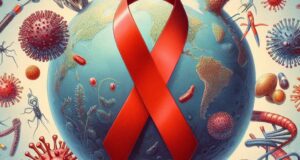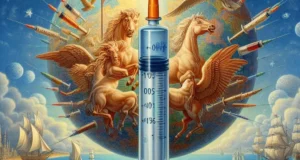In the green silence of the African rainforest, life pulses in the shadows—an ancient rhythm of predator and prey, survival and hunger. Among these dense trees, a trade as old as human history persists: the bushmeat trade. It’s a practice born from necessity—where wild animals are hunted for food. But hidden beneath this survival ritual lies a darker thread, one that reaches beyond the forest and into the veins of humanity.

“AIDS – where did it come from?” The answer begins here, in the flick of a hunter’s knife, in the exchange of blood between species. The story of AIDS isn’t just a tale of viruses and cells—it’s a story rooted in the raw, real interaction between man and wild animal.
Bushmeat, which includes animals like chimpanzees, monkeys, and bats, is a crucial source of protein for many rural communities. But with every hunted animal, especially primates, there exists a silent risk—a biological lottery where humans gamble with their health. These animals carry viruses adapted to their own species. When their bodies are butchered, cooked, or handled with bare hands, those viruses can cross the species barrier.
This is how scientists believe HIV-1, the virus responsible for the global AIDS pandemic, made its leap from chimpanzees to humans. Chimpanzees harbor SIV—Simian Immunodeficiency Virus—a relative of HIV. Through the bushmeat trade, likely during the cutting and consumption of infected meat, SIV slipped into the human bloodstream. Once inside, it mutated into HIV, and from there, history changed forever.
This wasn’t a lightning strike of infection—it was a slow burn. The early 1900s saw increased hunting, colonization, and movement through central Africa. Bushmeat was not only consumed locally—it was transported, traded, and sold, allowing the virus to travel beyond the jungle. A single event—perhaps one hunter, one meal—may have ignited what would eventually become a pandemic.
The bushmeat trade, then, becomes more than just an economic activity—it becomes a viral corridor, a bridge that connects the forests to the cities and the wildlife to our hospitals. And at the end of that corridor lies a global question still whispered today: “AIDS – where did it come from?”
What makes this story especially haunting is how invisible it once was. For decades, HIV simmered quietly in human populations. It took until the 1980s for doctors in the West to identify the syndrome. By then, the virus had already crossed continents and claimed lives. Only later, with genetic tracing and epidemiological studies, did scientists follow the path backwards—through cities, through villages, through blood—until they arrived at the forest edge, where chimpanzees once swung freely and humans hunted with bare hands.
The bushmeat trade, while steeped in cultural tradition and necessity, serves as a powerful metaphor: it’s where survival meets vulnerability. Where our closeness to nature becomes a potential doorway for pathogens to enter our world.

the answer lies not just in labs or test tubes, but in the blade of a hunter’s knife, the smoke of an open fire, and the trade routes that quietly moved bushmeat from jungle to city. It’s a story that reminds us how our ancient habits can spark modern tragedies.
Understanding the bushmeat trade’s role in the origin of AIDS helps illuminate the wider issue of zoonotic diseases—viruses that leap from animals to humans. As deforestation increases and wildlife encounters become more frequent, the risks of another such leap continue to grow.
AIDS came from the forest. From hunger. From survival. But with that knowledge, we gain power—the power to prevent the next virus from crossing that invisible bridge.




